Here are some specific activities, investigations or visual aids we have picked out. Click anywhere in the grey area to access the resource.
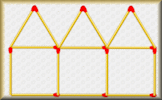 Matchstick Patterns Create a formula to describe the nth term of a sequence by examining the structure of the diagrams.
Matchstick Patterns Create a formula to describe the nth term of a sequence by examining the structure of the diagrams.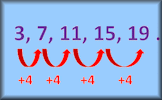 Arithmetic Sequences An exercise on linear sequences including finding an expression for the nth term and the sum of n terms.
Arithmetic Sequences An exercise on linear sequences including finding an expression for the nth term and the sum of n terms. Arithmetic Sequences Video A reminder of how to find the next term, the nth term and the sum of terms of an arithmetic or linear sequence.
Arithmetic Sequences Video A reminder of how to find the next term, the nth term and the sum of terms of an arithmetic or linear sequence.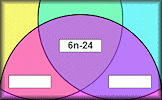 Venn Diagram of Sequences Find the formula for the nth term of sequences that belong in the given sets.
Venn Diagram of Sequences Find the formula for the nth term of sequences that belong in the given sets.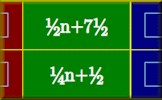 Sequences Table Challenge Complete the table showing the terms of the sequences and the formulas for the nth terms.
Sequences Table Challenge Complete the table showing the terms of the sequences and the formulas for the nth terms.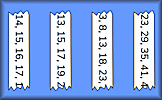 Parts of Sequences Find the formula that describes the part of the sequence that can be seen
Parts of Sequences Find the formula that describes the part of the sequence that can be seen Sigma Practise using the sigma notation to find the sum of various number series.
Sigma Practise using the sigma notation to find the sum of various number series.
Here are some exam-style questions on this statement:
- "(a) Find the \(n\)th term of the sequence 7, 13, 19, 25,..." ... more
- "The first three and last terms of an arithmetic sequence are \(7,13,19,...,1357\)" ... more
- "An arithmetic sequence is given by 6, 13, 20, …" ... more
- "In an arithmetic sequence, the fifth term is 44 and the ninth term is 80." ... more
- "A celebrity football match is planned to take place in a large stadium." ... more
- "An arithmetic sequence has first term 99 and common difference \(-5.5\)." ... more
- "A Grecian amphitheatre was built in the form of a horseshoe and has 22 rows." ... more
- "Consider an arithmetic sequence where \(u_{10}=S_{10}=15\). Find the value of the first term, \(u_1\) and the value of the common difference, \(d\)." ... more
- "Consider the arithmetic sequence \( u_1, u_2, u_3, \ldots \)." ... more
- "(a) Expand the following as the sum of six terms:" ... more
- "Consider the number sequence where \(u_1=500, u_2=519, u_3=538\) and \(u_4=557\) etc." ... more
Here is an Advanced Starter on this statement:
Click on a topic below for suggested lesson Starters, resources and activities from Transum.
Furthermore
Arithmetic sequences and series are fundamental concepts in mathematics. An arithmetic sequence is a sequence of numbers in which the difference between consecutive terms is constant. This difference is known as the common difference, denoted by \( d \).
The \( n^{th} \) term of an arithmetic sequence can be calculated using the formula:
$$ u_n = u_1 + (n - 1)d \\ \text{where } u_n \text{ is the } n^{th} \text{ term, } u_1 \text{ is the first term, and } d \text{ is the common difference.} $$The sum of the first \( n \) terms (\( S_n \)) of an arithmetic sequence can be found using the formula:
$$ S_n = \frac{n}{2}(2u_1 + (n - 1)d) \text{ or equivalently, } S_n = \frac{n}{2}(u_1 + u_n) \\ \text{where } S_n \text{ is the sum of the first } n \text{ terms.} $$Sigma notation (\( \Sigma \)) is a concise way to represent the sum of sequences. For an arithmetic sequence, it can be represented as:
$$ S_n = \sum_{r=1}^{n} (u_1 + (r - 1)d) $$Example 1: Consider an arithmetic sequence where the first term \( u_1 = 5 \) and the common difference \( d = 3 \). Let's find the \( 10^{th} \) term and the sum of the first 10 terms.
Using the formula for the \( n^{th} \) term:
$$ u_{10} = 5 + (10 - 1) \cdot 3 = 32 $$So, the \( 10^{th} \) term is 32.
Now, using the formula for the sum of the first \( n \) terms:
$$ S_{10} = \frac{10}{2}(2 \times 5 + (10 - 1) \cdot 3) = 185 $$Thus, the sum of the first 10 terms of the given arithmetic sequence is 185.
Example 2: For an arithmetic sequence with the first term \( u_1 = 2 \) and the common difference \( d = 7 \), we can represent the sum of the first 6 terms using sigma notation as:
This notation concisely represents the sum of the sequence: 2, 9, 16, 23, 30, and 37, which equals 117.
If you use a TI-Nspire GDC there are instructions here for generating a sequence on the calculator.
How do you teach this topic? Do you have any tips or suggestions for other teachers? It is always useful to receive feedback and helps make these free resources even more useful for Maths teachers anywhere in the world. Click here to enter your comments.

